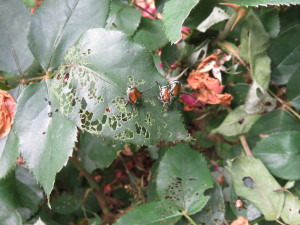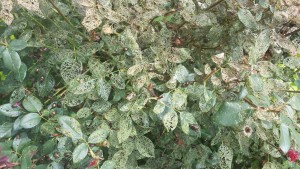In many areas of the Eastern U.S. Japanese beetles (JB) devastate the foliage, fruits and flowers of more than 300 plant species, particularly those in the rose family (Rosaceae). Adult beetles are approximately 3/8 inches in length with a dark metallic green head and metallic dark tan wings. In the soil JB grubs appear “C” shaped and feed primarily on grass roots, but also will feed on roots of corn, beans, tomatoes, and strawberries.
Grub populations between 7 and 15 per square foot can cause significant damage to non-irrigated turf. Grubs chew off grass roots and large dead patches of lawn result. Dead lawn patches can be rolled back like a carpet to expose the grubs in adjacent green areas. Natural predators such as moles, shrews, skunks, and crows may be also observed digging up grubs and causing damage to home lawns.
Japanese beetle life cycle
Adults emerge from the soil in late June (zone 7) to early July (zone 5), feed, mate, and lay eggs. Adult beetles mate and feed over a 6 to 8 week period and gradually die off. Each JB female can lay up to 60 eggs. She lays eggs in the turf. By late September grubs have grown to almost full-sized (about 1 inch long). In the fall, grubs begin to move deeper and spend the winter in a dormant state 2 to 8 inches below the surface. They begin to feed again in late April.
Inspect areas of brown turf and search in adjacent green areas for grubs and pupae. Insecticides are needed to control grubs and adults. Irrigating after applying an insecticide improves its action in the soil. However, too much rainfall (or over-irrigation) following an application may dilute the amount of insecticide in the soil. Grub infestations should be checked one week after an insecticide is applied. If after 10 days the grubs are still alive, apply a different product. Always read the pesticide label carefully before using.
The best time to apply insecticides for grubs is from mid-July to the end of September. Granular applied insecticides are generally applied with a spreader. Insecticides that kill grubs include products that contain imidacloprid, or biorational insecticides that do not harm beneficial insects in turf areas such as Ortho Grub-B-Gone™ ((halofenozide) and Acelepryn™. Milky spore disease (Bacillus popillae) has met with mixed success in killing JB grubs. It is sold under the brand names: Japidemic Doom™ and Milky Spore®.
Foliar sprays of contact insecticides kill JB adults, such as carbaryl (Sevin®), acephate (Orthene™), pyrethrins, and pyrethroids. Examples include pyrethroid products such as cyfluthrin (Tempo, Bayer Advanced Lawn & Garden Multi-Insect Killer), bifenthrin (TalstarOne), and permethrin (Spectracide Bug Stop Multi-Purpose Insect Control Concentrate™ and others).



 Posted in
Posted in 
